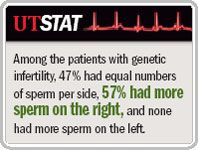Article
Sperm retrieval in NOA varicocele patients: Side matters
Author(s):
New Orleans-When retrieving sperm from men with nonobstructive azoospermia (NOA) and associated varicocele, go for the testis on the right side. That's the bottom line advice of University of California, San Francisco investigators who evaluated whether side matters in retrieving sperm for ICSI.

In cases of NOA with associated varicocele, there has not been scientific proof whether one testis is more likely to harbor sperm on retrieval than the other.
"We postulated that sperm production in the testis ipsilateral to the varicocele would be more profoundly affected, and used extensive cytologic and clinical data from fine needle aspiration [FNA] mapping to test this therapy," said Shai Shefi, MD, from Sheba Medical Center, Tel Hashomer, Israel, and a former fellow at UCSF working with Paul Turek, MD, when the research was conducted.
The mean left testis volume was 15.1 mL, and the mean right testis volume was 15 mL (p<.03). Six men (19%) had Y chromosome microdeletions and one had a balanced translocation (l:19). FNA sampling density was similar between testis sides. Investigators sampled an average of approximately 10 sites per side, looked for sperm at each site, and determined the proportion of FNA sites with sperm on each side.
Sperm was detected in at least one site in 20 patients (63%). Based on the percentage of positive FNA sites (PPS) for sperm in each testis, most men (75%) had equal proportions of sites positive for sperm in both testes, whereas 22% had more sperm on the right than the left testis. Far fewer men (3%) had more sperm on the left than right side, Dr. Shefi reported.
Based simply on the gross number of sperm-positive and sperm-negative sites in both testes, there were statistically fewer sperm-positive sites on the left (118/324) than on the right side (149/332) among the study subjects (p</=.003).
"When we put all these data together, from more than 650 FNA sites, the proportion of positive sites on the left was significantly lower than on the right," said Dr. Shefi. "Similar findings were found on two subgroups."
Subsets show similar patterns
In the nine patients with bilateral varicocele (181 sites), the same pattern was found, with 78% of patients having equal PPS on both sides, 22% having higher PPS on the right side, and no patients having higher PPS on the left. Again, there were statistically fewer sperm-positive sites on the left (p<.008).
In the seven patients with genetic infertility, the pattern was even more exaggerated, with 47% having equal numbers of sperm per side, 57% having higher PPS on the right, and no patients having higher PPS on the left. Right-dominant sites were more than twice as common as left-dominant sites (p<.0004).
"Our conclusion from this study is that FNA mapping can detect sperm pockets in 63% of NOA patients with varicocele. The majority of these have right-equal-to-left side sperm findings, but in most of the remaining patients, the right side exceeded the left. In subset analyses, most had a higher percentage of sperm detected in the right testis," Dr. Shefi said. "We therefore recommend that a sperm retrieval procedure in azoospermic men with varicocele should begin on the right side."
Session moderator Jay I. Sandlow, MD, vice chairman and associate professor of urology, Medical College of Wisconsin, Milwaukee, commented on the extensive experience this team of investigators has gained in testis mapping and said their findings are yielding clinically useful information.
















